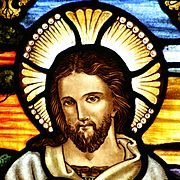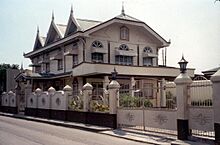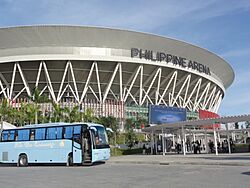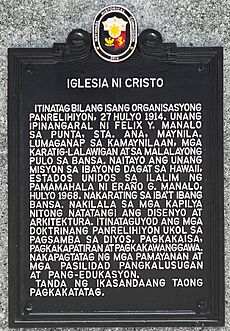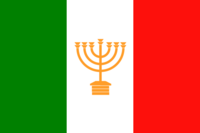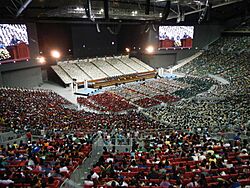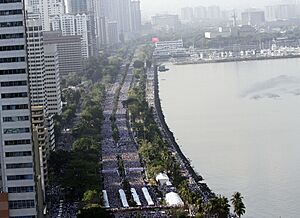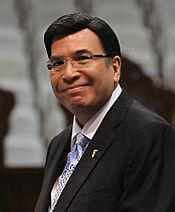Iglesia ni Cristo facts for kids
Quick facts for kids Iglesia ni Cristo |
|
|---|---|
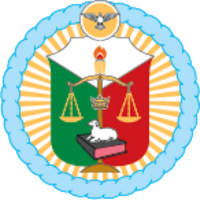
Seal
|
|
| Abbreviation | INC |
| Classification | Restorationism |
| Theology | Nontrinitarianism, Unitarianism |
| Governance | Central administration |
| Executive Minister | Eduardo V. Manalo |
| Region | 164 countries and territories |
| Language | Filipino, English |
| Headquarters | Quezon City, Philippines |
| Founder | Felix Manalo |
| Origin | July 27, 1914 (date registered to the Philippine government) Punta, Santa Ana, Manila, Philippine Islands |
| Congregations | approximately 7,000 |
| Members | 2.8 million (2020; Philippines only) |
| Ministers | 7,205 (2009) |
| Hospitals | New Era General Hospital |
| Aid organization |
|
| Primary schools | Yakap Orphanage |
| Tertiary institutions |
|
| Other name(s) | Church of Christ |
The Iglesia ni Cristo (INC), which means "Church of Christ" in English, is a Christian church that started in the Philippines. It was founded by Felix Manalo in 1913 and officially registered with the Philippine government on July 27, 1914.
The INC believes it is the original church that Jesus started. They teach that other Christian churches changed over time. According to INC teachings, Felix Manalo was God's last messenger. His registration of the church in 1914 was seen as a special event. It was believed to fulfill Bible predictions about the church being re-established in the Far East. This event also marked the beginning of the "end of days."
When Felix Manalo passed away in 1963, the INC had grown across the Philippines. It had 1,250 local chapels and 35 larger churches. His son, Eraño Manalo, took over and helped the church grow even more around the world. After Eraño Manalo's death in 2009, his son, Eduardo V. Manalo, became the new leader. In 2020, about 2.8 million people in the Philippines were members of the INC. This made it the third-largest religious group in the country.
Contents
History of the Iglesia ni Cristo
During the time when the United States governed the Philippines, many local movements with religious ideas appeared. American missionaries also brought different Christian churches to the Philippines. These offered new choices besides the Catholic Church, which was the main church during the Spanish colonial period.
Felix Y. Manalo: The Founder
Felix Y. Manalo was born on May 10, 1886, in Taguig, Philippines. He was baptized into the Catholic Church as a child. As a teenager, he started to question Catholic teachings. He explored different Christian groups, including the Methodist, Presbyterian, and Seventh-day Adventist churches. However, he felt that none of them truly followed the Bible.
In November 1913, Manalo spent three days studying the Bible by himself. He came out with new beliefs. He began preaching in Punta, Santa Ana, Manila, and later in his hometown of Taguig. At first, some people made fun of him, but he soon gained followers. On July 27, 1914, he officially registered his new religion as the Iglesia ni Cristo, or "Church of Christ." He became its first leader.
The church quickly grew. By 1924, it had thousands of members in Manila and nearby provinces. By 1936, there were 85,000 members, and by 1954, 200,000. The first church outside Luzon was built in Cebu in 1937. Missions to Mindanao began in 1946. During World War II, members who moved away from Manila helped spread the church. As Felix Manalo's health declined in the 1950s, his son Eraño began to take on more leadership roles. Felix Manalo passed away on April 12, 1963.
Growing Worldwide
On July 27, 1968, Eraño Manalo led the first worship service outside the Philippines in Hawaii. This marked the start of the church's international growth. Soon after, the INC established a congregation in San Francisco, California. The church reached Europe in 1971 through the United Kingdom and Canada in 1973. By 1998, the INC had 543 congregations and missions in 74 countries outside the Philippines.
The INC also started other projects. In 1965, it launched a program to help people resettle and get land in Nueva Ecija. The church began broadcasting on radio in 1969 and on television in 1983. In 1974, it opened a school for ministers, which later moved to Quezon City. The INC Central Office building was built in Quezon City in 1971. A large church called the Central Temple, which can hold 7,000 people, was added in 1984. The complex also includes New Era University, which is run by the INC. Eraño G. Manalo died on August 31, 2009. His son, Eduardo V. Manalo, became the new Executive Minister.
The 21st Century and Beyond
On July 21, 2014, the Philippine Arena was opened. This huge 55,000-seat building is owned by the INC. It holds the Guinness World Record for the largest mixed-use indoor theater. The Philippine government declared 2014 the "Iglesia ni Cristo Centennial Year" to celebrate the church's 100th anniversary. July 27, 2014, was made a special non-working holiday.
The INC celebrated its 100th anniversary at the Philippine Arena and in over a thousand other church buildings worldwide through live video. The celebration included worship services, musical shows, and other events. The centennial worship service set two Guinness World Records: the largest gospel choir and the largest mixed-use indoor theater. In 2015, the INC continued its centennial celebrations with international unity games and a closing event.
In October 2015, a film called Felix Manalo was shown. It told the story of the INC's beginnings and the life of its first leader. By 2018, the INC had more than 7,000 congregations in 151 countries. In May 2018, the INC organized a charity walk in Manila with over 283,000 participants. This set a new world record for the largest charity walk/run event.
What the Iglesia ni Cristo Believes
The Iglesia ni Cristo believes it is the true church that Jesus Christ established. They see its founding in the Philippines as fulfilling Bible prophecies that Christ's church would reappear in the Far East.
The Bible as Their Guide
The INC believes that the Bible is the only book inspired by God. Therefore, all their beliefs and practices come directly from the Bible.
God, Jesus, and the Holy Spirit
The Iglesia ni Cristo believes that God the Father is the only true God and the creator of everything. They do not believe in the traditional Christian idea of the Trinity (God as three persons). They teach that Jesus Christ is the Son of God and a special messenger from God. They believe Jesus was created by God the Father and is without sin. The church sees Jesus as God's greatest creation and believes he is a man, not God himself. Members believe that Jesus died to save humanity from sin.
The INC also believes that the Holy Spirit is God's power, not a separate person or deity. They believe the Holy Spirit is sent by God the Father and Jesus Christ to guide God's people.
The One True Church
The Iglesia ni Cristo teaches that it is the one true church founded by Jesus Christ. They believe that the early church changed over time and that the Catholic Church is an example of this change. The INC sees its re-establishment by Felix Manalo as a sign that the "end of days" is near.
They believe that the Bible verse Isaiah 43:5, which mentions "east," refers to the Philippines where the Church of Christ was founded. The INC teaches that only its members are chosen by God for salvation. They believe that simply having faith is not enough for salvation. The official name of the true church, according to them, is "Church of Christ" or "Iglesia ni Cristo."
Felix Manalo as God's Messenger
The INC believes that Felix Manalo is the "angel from the east" mentioned in Revelation 7:1–3. They say he began preaching about the INC when World War I started. This time is referred to in the Bible as the "ends of the earth," meaning the time when the end of the world is near. Manalo came from the Philippines, which they consider to be in the "center" of the Far East.
As the one sent by God to restore the INC, Felix Manalo became the first leader and spiritual guide of the church. He taught that the Bible was the highest authority. As God's messenger, Manalo is seen as the most important Bible expert for all people and the leader of the re-established Church of Christ in modern times.
Baptism
The church believes that baptism is done by fully immersing adults in water. They teach that it is necessary to be baptized in the Iglesia ni Cristo to become a follower of Jesus Christ. The church does not baptize babies. Instead, new babies of members are dedicated to God through a special prayer led by a minister.
Following Church Rules
Members who do not follow the teachings of the INC are given advice. If they continue to break church rules after being advised, they may be removed from the church. This means they would lose their chance at salvation. The church does not believe that once a person is saved, they are always saved. Certain actions, like not attending church services regularly without a good reason, can lead to removal.
Life After Death
The INC believes that a person is made of a body, a soul, and a spirit. They teach that when a person dies, their body and soul die and stay in the grave until Jesus Christ returns. The spirit, however, goes back to God. When Christ returns, all faithful servants of God, both living and dead, will be brought back to life. They will be rewarded by living in the Holy City, or New Jerusalem, with God the Father and Jesus Christ. Later, non-INC members will experience a "second death," which is described as the Lake of Fire.
The church believes that God has set a day to judge all people. They believe this day is also when Jesus Christ will return.
Joining Labor Organizations
The INC teaches that its members should not join labor unions. This belief comes from their interpretation of a Bible verse that says church members should not join organizations with non-members.
Practices of the Iglesia ni Cristo
Worship and Prayer
The church holds worship services twice a week, once during the week and once on the weekend. These services are held in local languages, and some churches offer sign language interpreters. During services, members sing hymns, pray, study the Bible, and give voluntary offerings. Both God the Father and Jesus are worshiped. Ministers use the same sermon outline prepared by the Executive Minister. Deacons and Deaconesses help guide people to their seats and collect offerings. Choirs lead the singing of hymns. The first hymnbook was published in 1937.
Children also have their own worship services every weekend. These services use similar lessons but are taught through questions and answers. The church teaches that missing worship services on purpose is a serious sin. Members are expected to attend services twice a week without fail.
The church encourages its members to pray every day. They pray before meals and before going to sleep. They do not use prayers that are simply repeated from memory.
Sharing Their Faith
Since 1939, the church has published Pasugo ('God's Message') in both Tagalog and English. This magazine shares INC beliefs and explains church history and missionary work. It also lists newly built churches. In 2009, over four million copies of Pasugo were given out worldwide.
In the Philippines, the INC broadcasts Bible teachings on radio and television through Christian Era Broadcasting Service. These programs are aired on many radio stations and on INCTV 48, which is available on cable and online.
The INC regularly holds large religious gatherings called evangelical missions to invite more people to join. In February 2012, the INC held its largest missions across 19 sites in the Philippines. Over 600,000 people attended the event in Manila alone. In 2013, they started "Lingap-Pamamahayag," which combines outreach with evangelical missions. In September 2015, the INC held its first worldwide evangelical mission, with the Philippine Arena as the main location and over 2,000 other sites connected by video.
Community Outreach
Since 1981, the INC has run the Lingap sa Mamamayan ('Aid To Humanity') Program. This program provides food, health care, and other help to people in need, especially after disasters. It also offers seminars on disaster preparedness and first aid. Other activities like blood donations and community clean-ups are held worldwide.
The Felix Y. Manalo (FYM) Foundation is the INC's group that carries out these aid programs. It was officially registered in the Philippines in 2011 and in the United States in 2012.
In July 2012, the INC's Lingap sa Mamamayan event in Tondo, Manila, set three Guinness World Records for health checks. In April 2016, they broke four more Guinness World Records for collecting clothes, donating shoes, and providing medical exams.
In February 2014, the INC set two more Guinness World Records for the largest charity walk. Over 175,000 members walked in Manila, and over 519,000 participated worldwide. The money raised helped survivors of Typhoon Haiyan. The INC broke these records again in May 2018 with over 283,000 people in one location and over 773,000 worldwide.
In February 2014, the INC also set a world record for distributing over 302,000 hunger relief packages in eight hours. In March 2014, the INC started a large community project in Leyte for typhoon survivors. This project included over 1,000 homes, factories, and farms to provide jobs. In January 2015, the project was officially opened.
In November 2015, Eduardo V. Manalo opened a community project for the Kabihug tribe in Camarines Norte. This project included homes, farms, factories, a clinic, and an INC worship building. In May 2016, another similar project was opened for the B'laan tribe in South Cotabato.
How the Iglesia ni Cristo is Organized
| Iglesia ni Cristo Executive Ministers | |
|---|---|
| Name | Time in Office |
|
|
|
| Felix Y. Manalo | July 27, 1914 – April 12, 1963 |
| Eraño G. Manalo | April 23, 1963 – August 31, 2009 |
| Eduardo V. Manalo | September 7, 2009 – present |
The Iglesia ni Cristo has had three Executive Ministers who lead the church. Eduardo V. Manalo is the current Executive Minister. He manages the church's operations with the help of other senior ministers.
The main office of the Iglesia ni Cristo is in Quezon City. It was built in 1971 and houses the offices for the church's leaders and departments. Many INC professionals and volunteers work there. The INC also has three main offices outside the Philippines: in Burlingame, California; Washington D.C.; and Heathrow, London.
The church's work is divided into districts, each led by a District Minister. Each district has about 40 local churches. Felix Y. Manalo managed all churches directly until 1924, when the first district was formed in Pampanga.
Church Buildings and Design
Iglesia ni Cristo church buildings are mainly used for worship services and other religious events. These buildings often have a unique look. They feature tall, narrow windows, interlocking shapes, and flower-like designs. They also have towers and spires that point upwards, symbolizing the faithful reaching out to God.
Churches have multiple entrances leading to the main area where men and women sit on different sides. The choir is usually behind the main stage. Larger churches also have a baptistry with pools for immersion baptism. Famous architects like Juan Nakpil and Carlos A. Santos-Viola helped design INC churches. The church's own Engineering and Construction Department, started in 1971, makes sure all church buildings have a similar design.
The first chapel was built in Tondo, Manila, in 1918, using local materials like woven leaf panels and wood. After World War II, the INC started building concrete chapels. The Central Temple, which opened in 1984, can hold up to 7,000 people. It has unique octagonal spires and ribbed windows. Newer buildings often use similar designs. Churches outside the Philippines that were bought from other religions are renovated to fit the INC's worship style.
Political Influence in the Philippines

The Iglesia ni Cristo is known for its practice of bloc voting during elections. This means that members are often encouraged to vote for the same candidates. For example, during the 2016 presidential election, INC communities in some areas gave almost all their votes to the candidates the church supported. The church supported Benigno Aquino III in 2010 and Rodrigo Duterte in 2016 for president. In the 2022 elections, the church supported Ferdinand "Bongbong" Marcos Jr. for president and Sara Duterte for vice president. The church also supported the senatorial candidacy of INC member Rodante Marcoleta in the 2025 elections.
On June 12, 2009, July 27 was declared "Iglesia ni Cristo Day," a special national working holiday. On February 13, 2018, President Rodrigo Duterte appointed Eduardo Manalo as a special envoy for overseas Filipino concerns. President Bongbong Marcos reappointed him to this role, which lasted until September 1, 2024. On October 31, 2024, President Bongbong Marcos declared July 27, 2025, as "Iglesia ni Cristo Day," a special non-working holiday.
In December 2024, the INC announced plans for a rally to oppose efforts to remove Vice President Sara Duterte from office. This aligned with President Marcos's view that such efforts were not helpful. On January 13, 2025, over 1.5 million INC members attended a "National Rally for Peace" in Manila, with other rallies held across the country.
Felix Y. Manalo Foundation
The Felix Y. Manalo (FYM) Foundation is the part of the Iglesia ni Cristo that helps people. It manages the church's international aid programs. These programs offer free medical and dental clinics, help with education, and provide disaster relief and other important goods to communities in need.
In August 2022, the FYM Foundation worked with Iglesia ni Cristo churches in Canada. They gave out 2,000 bags of groceries and donated money to local charities during a "Care for Humanity" event. In 2022, the FYM Foundation received an award called the "Banaag" category of the 2021 Presidential Award for Filipino Individuals and Organizations Overseas.
Images for kids
See also
 In Spanish: Iglesia ni Cristo para niños
In Spanish: Iglesia ni Cristo para niños
- Christian Era Broadcasting Service International
- Eagle Broadcasting Corporation
- DZEM
- DZCE-TV
- DZEC-TV
- Net 25


